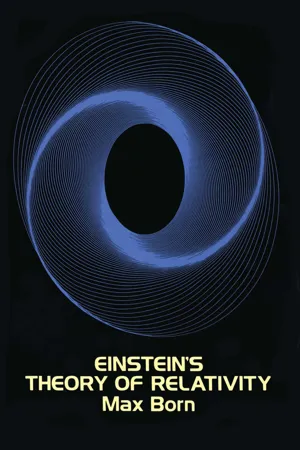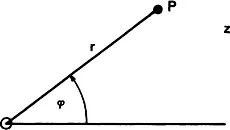![]()
CHAPTER I
GEOMETRY AND COSMOLOGY
1. The Origin of the Art of Measuring Space and Time
The physical problem presented by space and time consists in fixing numerically a place and a point of time for every physical event, thus enabling us to single it out, as it were, from the chaos of the coexistence and succession of things.
The first problem of man was to find his way about on the earth. Hence the art of measuring the earth (geodesy) became the source of the science of space, which derived its name “geometry” from the Greek word for earth. From the very outset, however, the measure of time arose from the regular changes of night and day, the phases of the moon, and the seasons. These phenomena forced themselves on man’s attention and caused him to direct his gaze toward the stars, which were the source of the science of the universe, cosmology. Astronomic technique applied to the heavenly regions the teachings of geometry that had been tested on the earth, allowing distances and orbits to be defined, and gave the inhabitants of the earth the celestial (astronomic) measure of time which taught them to distinguish between past, present, and future, and to assign to each event its place in time.
2. Units of Length and Time
The foundation of every space and time measurement is laid by fixing the unit. The phrase “a length of so and so many meters” denotes the ratio of the length to be measured to the length of a meter. The phrase “a time of so many seconds” denotes the ratio of the time to be measured to the duration of a second. Thus we are always dealing with ratios, relative data concerning units which are themselves to a high degree arbitrary, and are chosen for reasons of their being easily reproduced, easily transported, durable, and so forth.
In physics the measure of length is the centimeter (cm.), the hundredth part of a meter rod that is preserved in Paris. This was originally intended to bear a simple ratio to the circumference of the earth—namely, to be the ten-millionth part of a quadrant—but more recent measurements have disclosed that this statement is not accurate.
The unit of time in physics is the second (sec.), which bears the well-known relation to the time of rotation of the earth on its axis.
These definitions of the units derived from the circumference and rotation of the earth have turned out to be inconvenient. Today we use more readily reproducible units based on the atomic properties of matter. Thus the meter is now defined by saying that it contains a certain number of wave lengths of a certain, well-defined electromagnetic radiation sent out by a cadmium atom. The second can be defined as a given multiple of the oscillation time of certain molecules.
3. Origin and Coordinate System
If we wish not only to determine lengths and periods of time but also to designate places and points of time, further conventions must be made. In the case of time, which we regard as a one-dimensional configuration, it is sufficient to specify an origin (or zero point). Historians reckon dates by counting the years from the birth of Christ. Astronomers choose other origins or initial points, according to the objects of their researches; these they call epochs. If the unit and the origin are fixed, every event may be singled out by assigning a number to it.
In geometry in the narrower sense, in order to determine position on the earth, two data must be given to fix a point. To say “My house is on Baker Street” is not sufficient to locate it. The house number must also be given. In many American towns the streets themselves are numbered. The address 25 13th Street thus consists of two number data. It is exactly what mathematicians call a “coordinate determination.” The earth’s surface is covered with a network of intersecting lines which are numbered, or whose position is determined by a number, distance, or angle (made with respect to a fixed initial line or zero-line).
Geographers generally use geographic longitude (east or west of Greenwich) and latitude (north or south of the equator) (Fig. 1).
Fig. 1 Geographic longitude and latitude of a point P on the earth’s surface. is counted from the meridian of Greenwich, from the equator. N and S are the North and the South Poles. These determinations at the same time fix the zero lines from which the coordinates are to be reckoned—for geographical longitude, the meridian of Greenwich, and for the latitude, the equator. In investigations of plane geometry we generally use rectangular (Cartesian) coordinates (Fig. 2a) x, y, which signify the distances from two mutually perpendicular coordinate axes; or occasionally we also use oblique coordinates (Fig.2b), polar coordinates (Fig. 3), and others.
Fig. 2 A point P in the plane is defined by the projections on the axis x and y in a rectangular coordinate system (2a) or in an oblique coordinate system (2b).
Fig. 3 Definition of P in polar coordinates by the distance r
from the origin O and the angle from an axis through the origin. Fig. 4 A point P in space is defined by three axis intercepts x, y, z of a rectangular coordinate system.
When the coordinate system has been specified, we can determine each point by giving it two numbers.
In precisely the same way we require three coordinates to fix points in space. Mutually perpendicular rectilinear coordinates are again the simplest choice; we denote them by x, y, z (Fig. 4).
4. The Axioms of Geometry
Ancient geometry, regarded as a science, was less concerned with the question of fixing positions on the earth’s surface than with determining the size and form of areas, volumes of figures in space, and the laws governing these figures. Geometry originated in the arts of surveying and architecture. Thus it managed without the concept of coordinates. First and foremost, geometric theorems assert properties of things that are called points, straight lines, and planes. In the classic canon of Greek geometry, the work of Euclid (300 B.C.), these things are not defined further but are only named or described. Thus an appeal to intuition is made. You must already know what a straight line is if you wish to take up the study of geometry. Picture the edge of a house, or a stretched string; abstract what is material and you will get your straight line. Next, laws are set up that are to hold between configurations of such abstract things. It is to the credit of the Greeks to have made the great discovery that we need assume only a small number of these statements to derive all others correctly with logical inevitability. These statements which are used as the foundation are called axioms. Their correctness cannot be proved. They do not arise from logic but from other sources of knowledge. What these sources are has formed a subject for the philosophical speculations of succeeding centuries. The science of geometry itself, up to the end of the eighteenth century, accepted these axioms as given, and built up its purely deductive system of theorems on them.
Later we shall have to discuss the question of the meaning of the elementary configurations called point, straight line, and so forth, and the sources of our knowledge of the geometric axioms. For the present, however, we shall assume that we are clear about these things and shall thus operate with the geometric concepts in the way we learned at school. The intuitive truth of numerous geometric theorems and the utility of the whole system in giving us bearings in our ordinary real world are sufficient for the present as our justification for using them.
5. The Ptolemaic System
To the eye the sky appears as a more or less flat dome to which stars are attached. In the course of a day the whole dome turns about an axis whose position on the sky is very close to the polestar. So long as this visual appearance was regarded as reality, an application of geometry to astronomic space was superfluous and was, as a matter of fact, not carried out. There were no lengths and distances measurable with terrestrial units. To determine the position of a star one had only to know the pair of angles formed by the observer’s line of vision to the star with respect to the horizon and with respect to another appropriately chosen plane. At this stage of knowledge the earth’s surface was considered at rest and was the eternal basis of the universe. The words “above” and “below” had an absolute meaning, and when poetic fancy or philosophical speculation undertook to estimate the height of the heavens or the depth of Tartarus, the meaning of these terms required no explanation. Scientific concepts were still being drawn from the abundance of subjective data. The world system named after Ptolemy (A.D. 150) is the scientific formulation of this frame of mind. It was already aware of a great number of facts concerning the motion of the sun, the moon, and the planets and provided theoretical methods to predict them, but it retained the notion that the earth is at rest and that the stars are revolving about it at immeasurable distances. Their orbits were assumed to be circles and epicycles according to the laws of terrestrial geometry, yet astronomic space was not actually considered as an object for geometrical consideration, for the orbits were fastened like rings to crystal spheres, which, arranged in shells, formed the sky.
6. The Copernican System
It is known that Greek thinkers had already discovered the spherical shape of the earth and had ventured to take the first steps from the geocentric world systems (Aristarchus, third century B.C.) to higher abstractions. But only long after Greek civilization and culture had died did the peoples of other countries accept the spherical shape of the earth as a physical reality. This is the first truly great departure from the evidence of our eyes, and at the same time the first truly great step towards relativization. Centuries have passed since that first turning point, and what was at that time an unprecedented discovery has now become a platitude for school children. This makes it difficult to convey an impression of what it meant to people of that time to see...









